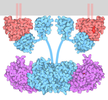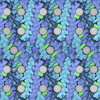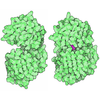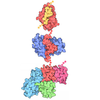+ Open data
Open data
- Basic information
Basic information
| Entry |  | |||||||||
|---|---|---|---|---|---|---|---|---|---|---|
| Title | Lgl2 bound to the aPKCiota-Par6A complex in its ADP-bound form | |||||||||
 Map data Map data | ||||||||||
 Sample Sample |
| |||||||||
 Keywords Keywords | Cell Polarity / Kinase / Complex / LIPID BINDING PROTEIN | |||||||||
| Function / homology |  Function and homology information Function and homology informationestablishment of spindle orientation / establishment or maintenance of polarity of embryonic epithelium / diacylglycerol-dependent, calcium-independent serine/threonine kinase activity / Golgi vesicle budding / PAR polarity complex / Tight junction interactions / regulation of establishment or maintenance of cell polarity / protein kinase C / establishment of apical/basal cell polarity / diacylglycerol-dependent serine/threonine kinase activity ...establishment of spindle orientation / establishment or maintenance of polarity of embryonic epithelium / diacylglycerol-dependent, calcium-independent serine/threonine kinase activity / Golgi vesicle budding / PAR polarity complex / Tight junction interactions / regulation of establishment or maintenance of cell polarity / protein kinase C / establishment of apical/basal cell polarity / diacylglycerol-dependent serine/threonine kinase activity / L-leucine transport / myosin II binding / regulation of Notch signaling pathway / negative regulation of glial cell apoptotic process / eye photoreceptor cell development / branching involved in labyrinthine layer morphogenesis / Schmidt-Lanterman incisure / establishment or maintenance of epithelial cell apical/basal polarity / Golgi to plasma membrane transport / membrane organization / cellular response to chemical stress / cell-cell junction organization / cortical actin cytoskeleton organization / protein targeting to membrane / tight junction / labyrinthine layer blood vessel development / cortical actin cytoskeleton / positive regulation of Notch signaling pathway / establishment of cell polarity / cell leading edge / exocytosis / brush border / positive regulation of endothelial cell apoptotic process / positive regulation of glial cell proliferation / bicellular tight junction / regulation of postsynaptic membrane neurotransmitter receptor levels / intercellular bridge / vesicle-mediated transport / cytoskeleton organization / secretion / p75NTR recruits signalling complexes / response to interleukin-1 / GTPase activator activity / actin filament organization / positive regulation of D-glucose import / post-embryonic development / protein localization to plasma membrane / positive regulation of protein localization to plasma membrane / PDZ domain binding / adherens junction / positive regulation of NF-kappaB transcription factor activity / positive regulation of neuron projection development / phospholipid binding / Pre-NOTCH Transcription and Translation / Schaffer collateral - CA1 synapse / multicellular organism growth / cellular response to insulin stimulus / KEAP1-NFE2L2 pathway / cell migration / microtubule cytoskeleton / negative regulation of neuron apoptotic process / protein phosphorylation / protein kinase activity / endosome / intracellular signal transduction / cilium / apical plasma membrane / Golgi membrane / cell division / protein serine kinase activity / intracellular membrane-bounded organelle / protein serine/threonine kinase activity / negative regulation of apoptotic process / glutamatergic synapse / extracellular exosome / zinc ion binding / nucleoplasm / ATP binding / nucleus / plasma membrane / cytoplasm / cytosol Similarity search - Function | |||||||||
| Biological species |  Homo sapiens (human) Homo sapiens (human) | |||||||||
| Method | single particle reconstruction / cryo EM / Resolution: 3.31 Å | |||||||||
 Authors Authors | Almagor L / Weis WI | |||||||||
| Funding support | 1 items
| |||||||||
 Citation Citation |  Journal: Commun Biol / Year: 2025 Journal: Commun Biol / Year: 2025Title: Polarity protein Par6 facilitates the processive phosphorylation of Lgl via a dynamic interaction with aPKC. Authors: Lior Almagor / William I Weis /  Abstract: Polarity along an apical-basal axis is essential for epithelial cell shape and function. The atypical protein Kinase-C (aPKC) and its regulatory partner Par6 form a complex that is essential for ...Polarity along an apical-basal axis is essential for epithelial cell shape and function. The atypical protein Kinase-C (aPKC) and its regulatory partner Par6 form a complex that is essential for polarization, a primary function of which is to phosphorylate the Lethal giant larvae (Lgl) protein to prevent it from binding to the apical membrane (thereby facilitating its basolateral localization). Par6 binds Lgl directly and is essential for this process, but its mechanism was obscure. Here, we utilize cryo-EM and various biochemical techniques to characterize the interaction of Lgl2 with the aPKCι/Par6 complex and to study the roles of Par6 in promoting Lgl2 phosphorylation. We find that Par6 proteins stabilize a ternary Lgl2/aPKCι/Par6 complex that involves a unique multi-surface interaction of Lgl2 with both aPKCι and Par6. Importantly, we find Par6b induces processive phosphorylation that results in a multi-phosphorylated Lgl2 after a single interaction with the aPKCι/Par6b complex. This is enabled by a Par6b/Lgl2 interaction that maintains contact of Lgl2 with the kinase throughout its distinct nucleotide-binding states. Our results reveal the mechanistic basis for the efficient regulation of Lgl's membrane binding by aPKC/Par6 and provide invaluable structural data for further understanding the mechanisms of this polarity complex. | |||||||||
| History |
|
- Structure visualization
Structure visualization
| Supplemental images |
|---|
- Downloads & links
Downloads & links
-EMDB archive
| Map data |  emd_48107.map.gz emd_48107.map.gz | 483.1 MB |  EMDB map data format EMDB map data format | |
|---|---|---|---|---|
| Header (meta data) |  emd-48107-v30.xml emd-48107-v30.xml emd-48107.xml emd-48107.xml | 17.6 KB 17.6 KB | Display Display |  EMDB header EMDB header |
| FSC (resolution estimation) |  emd_48107_fsc.xml emd_48107_fsc.xml | 17.1 KB | Display |  FSC data file FSC data file |
| Images |  emd_48107.png emd_48107.png | 100.5 KB | ||
| Filedesc metadata |  emd-48107.cif.gz emd-48107.cif.gz | 6.2 KB | ||
| Others |  emd_48107_half_map_1.map.gz emd_48107_half_map_1.map.gz emd_48107_half_map_2.map.gz emd_48107_half_map_2.map.gz | 474.1 MB 474.1 MB | ||
| Archive directory |  http://ftp.pdbj.org/pub/emdb/structures/EMD-48107 http://ftp.pdbj.org/pub/emdb/structures/EMD-48107 ftp://ftp.pdbj.org/pub/emdb/structures/EMD-48107 ftp://ftp.pdbj.org/pub/emdb/structures/EMD-48107 | HTTPS FTP |
-Validation report
| Summary document |  emd_48107_validation.pdf.gz emd_48107_validation.pdf.gz | 1.1 MB | Display |  EMDB validaton report EMDB validaton report |
|---|---|---|---|---|
| Full document |  emd_48107_full_validation.pdf.gz emd_48107_full_validation.pdf.gz | 1.1 MB | Display | |
| Data in XML |  emd_48107_validation.xml.gz emd_48107_validation.xml.gz | 26.4 KB | Display | |
| Data in CIF |  emd_48107_validation.cif.gz emd_48107_validation.cif.gz | 34.4 KB | Display | |
| Arichive directory |  https://ftp.pdbj.org/pub/emdb/validation_reports/EMD-48107 https://ftp.pdbj.org/pub/emdb/validation_reports/EMD-48107 ftp://ftp.pdbj.org/pub/emdb/validation_reports/EMD-48107 ftp://ftp.pdbj.org/pub/emdb/validation_reports/EMD-48107 | HTTPS FTP |
-Related structure data
| Related structure data |  9ejkC  9ejlC  9ejmC C: citing same article ( |
|---|---|
| Similar structure data | Similarity search - Function & homology  F&H Search F&H Search |
- Links
Links
| EMDB pages |  EMDB (EBI/PDBe) / EMDB (EBI/PDBe) /  EMDataResource EMDataResource |
|---|---|
| Related items in Molecule of the Month |
- Map
Map
| File |  Download / File: emd_48107.map.gz / Format: CCP4 / Size: 512 MB / Type: IMAGE STORED AS FLOATING POINT NUMBER (4 BYTES) Download / File: emd_48107.map.gz / Format: CCP4 / Size: 512 MB / Type: IMAGE STORED AS FLOATING POINT NUMBER (4 BYTES) | ||||||||||||||||||||||||||||||||||||
|---|---|---|---|---|---|---|---|---|---|---|---|---|---|---|---|---|---|---|---|---|---|---|---|---|---|---|---|---|---|---|---|---|---|---|---|---|---|
| Projections & slices | Image control
Images are generated by Spider. | ||||||||||||||||||||||||||||||||||||
| Voxel size | X=Y=Z: 0.5555 Å | ||||||||||||||||||||||||||||||||||||
| Density |
| ||||||||||||||||||||||||||||||||||||
| Symmetry | Space group: 1 | ||||||||||||||||||||||||||||||||||||
| Details | EMDB XML:
|
-Supplemental data
-Half map: #1
| File | emd_48107_half_map_1.map | ||||||||||||
|---|---|---|---|---|---|---|---|---|---|---|---|---|---|
| Projections & Slices |
| ||||||||||||
| Density Histograms |
-Half map: #2
| File | emd_48107_half_map_2.map | ||||||||||||
|---|---|---|---|---|---|---|---|---|---|---|---|---|---|
| Projections & Slices |
| ||||||||||||
| Density Histograms |
- Sample components
Sample components
-Entire : A ternary complex of Lgl2 with aPKC iota and Par6A (ADP-bound)
| Entire | Name: A ternary complex of Lgl2 with aPKC iota and Par6A (ADP-bound) |
|---|---|
| Components |
|
-Supramolecule #1: A ternary complex of Lgl2 with aPKC iota and Par6A (ADP-bound)
| Supramolecule | Name: A ternary complex of Lgl2 with aPKC iota and Par6A (ADP-bound) type: complex / ID: 1 / Parent: 0 / Macromolecule list: all |
|---|---|
| Source (natural) | Organism:  Homo sapiens (human) Homo sapiens (human) |
| Molecular weight | Theoretical: 216.9931 KDa |
-Macromolecule #1: Lethal Giant Larvae homolog 2 (Lgl2)
| Macromolecule | Name: Lethal Giant Larvae homolog 2 (Lgl2) / type: protein_or_peptide / ID: 1 / Enantiomer: LEVO |
|---|---|
| Source (natural) | Organism:  Homo sapiens (human) Homo sapiens (human) |
| Recombinant expression | Organism:  |
| Sequence | String: MRERLKRDLF QFNKTVEHGF PHQPSALGYS PSLRILAIGT RSGAIKLYGA PGVEFMGLHQ ENNAVTQIHL LPGQCQLVTL LDDNSLHLWS L KVKGGASE LQEDESFTLR GPPGAAPSAT QITVVLPHSS CELLYLGTES GNVFVVQLPA FRALEDRTIS SDAVLQRLPE ...String: MRERLKRDLF QFNKTVEHGF PHQPSALGYS PSLRILAIGT RSGAIKLYGA PGVEFMGLHQ ENNAVTQIHL LPGQCQLVTL LDDNSLHLWS L KVKGGASE LQEDESFTLR GPPGAAPSAT QITVVLPHSS CELLYLGTES GNVFVVQLPA FRALEDRTIS SDAVLQRLPE EARHRRVFEM VE ALQEHPR DPNQILIGYS RGLVVIWDLQ GSRVLYHFLS SQQLENIWWQ RDGRLLVSCH SDGSYCQWPV SSEAQQPEPL RSLVPYGPFP CKA ITRILW LTTRQGLPFT IFQGGMPRAS YGDRHCISVI HDGQQTAFDF TSRVIGFTVL TEADPAATFD DPYALVVLAE EELVVIDLQT AGWP PVQLP YLASLHCSAI TCSHHVSNIP LKLWERIIAA GSRQNAHFST MEWPIDGGTS LTPAPPQRDL LLTGHEDGTV RFWDASGVCL RLLYK LSTV RVFLTDTDPN ENFSAQGEDE WPPLRKVGSF DPYSDDPRLG IQKIFLCKYS GYLAVAGTAG QVLVLELNDE AAEQAVEQVE ADLLQD QEG YRWKGHERLA ARSGPVRFEP GFQPFVLVQC QPPAVVTSLA LHSEWRLVAF GTSHGFGLFD HQQRRQVFVK CTLHPSDQLA LEGPLSR VK SLKKSLRQSF RRMRRSRVSS RKRHPAGPPG EAQEGSAKAE RPGLQNMELA PVQRKIEARS AEDSFTGFVR TLYFADTYLK DSSRHCPS L WAGTNGGTIY AFSLRVPPAE RRMDEPVRAE QAKEIQLMHR APVVGILVLD GHSVPLPEPL EVAHDLSKSP DMQGSHQLLV VSEEQFKVF TLPKVSAKLK LKLTALEGSR VRRVSVAHFG SRRAEDYGEH HLAVLTNLGD IQVVSLPLLK PQVRYSCIRR EDVSGIASCV FTKYGQGFYL ISPSEFERF SLSTKWLVEP RCLVDSAETK NHRPGNGAGP KKAPSRARNS GTQSDGEEKQ PGLVMEREFT TASHHHHHHG ENLYFQ UniProtKB: LLGL scribble cell polarity complex component 2 |
-Macromolecule #2: Atypical protein kinase C (aPKC) iota
| Macromolecule | Name: Atypical protein kinase C (aPKC) iota / type: protein_or_peptide / ID: 2 / Enantiomer: LEVO / EC number: protein kinase C |
|---|---|
| Source (natural) | Organism:  Homo sapiens (human) Homo sapiens (human) |
| Recombinant expression | Organism:  |
| Sequence | String: MPTQRDSSTM SHTVAGGGSG DHSHQVRVKA YYRGDIMITH FEPSISFEGL CNEVRDMCSF DNEQLFTMKW IDEEGDPCTV SSQLELEEAF RLYELNKDSE LLIHVFPCVP ERPGMPCPGE DKSIYRRGAR RWRKLYCANG HTFQAKRFNR RAHCAICTDR IWGLGRQGYK ...String: MPTQRDSSTM SHTVAGGGSG DHSHQVRVKA YYRGDIMITH FEPSISFEGL CNEVRDMCSF DNEQLFTMKW IDEEGDPCTV SSQLELEEAF RLYELNKDSE LLIHVFPCVP ERPGMPCPGE DKSIYRRGAR RWRKLYCANG HTFQAKRFNR RAHCAICTDR IWGLGRQGYK CINCKLLVHK KCHKLVTIEC GRHSLPQEPV MPMDQSSMHS DHAQTVIPYN PSSHESLDQV GEEKEAMNTR ESGKASSSLG LQDFDLLRVI GRGSYAKVLL VRLKKTDRIY AMKVVKKELV NDDEDIDWVQ TEKHVFEQAS NHPFLVGLHS CFQTESRLFF VIEYVNGGDL MFHMQRQRKL PEEHARFYSA EISLALNYLH ERGIIYRDLK LDNVLLDSEG HIKLTDYGMC KEGLRPGDTT S(TPO)FCGTPNYI APEILRGEDY GFSVDWWALG VLMFEMMAGR SPFDIVGSSD NPDQNTEDYL FQVILEKQIR IPRSLSVKAA SVLKSFLNKD PKERLGCHPQ TGFADIQGHP FFRNVDWDMM EQKQVVPPFK PNISGEFGLD NFDSQFTNEP VQL(TPO)PDDDDI VRKIDQSEFE GFEYINPLLM SAEECV UniProtKB: Protein kinase C iota type |
-Macromolecule #3: Partitioning defective 6 homolog alpha (Par6A)
| Macromolecule | Name: Partitioning defective 6 homolog alpha (Par6A) / type: protein_or_peptide / ID: 3 / Enantiomer: LEVO |
|---|---|
| Source (natural) | Organism:  Homo sapiens (human) Homo sapiens (human) |
| Recombinant expression | Organism:  |
| Sequence | String: MARPQRTPAR SPDSIVEVKS KFDAEFRRFA LPRASVSGFQ EFSRLLRAVH QIPGLDVLLG YTDAHGDLLP LTNDDSLHRA LASGPPPLRL LVQKREADSS GLAFASNSLQ RRKKGLLLRP VAPLRTRPPL LISLPQDFRQ VSSVIDVDLL PETHRRVRLH KHGSDRPLGF ...String: MARPQRTPAR SPDSIVEVKS KFDAEFRRFA LPRASVSGFQ EFSRLLRAVH QIPGLDVLLG YTDAHGDLLP LTNDDSLHRA LASGPPPLRL LVQKREADSS GLAFASNSLQ RRKKGLLLRP VAPLRTRPPL LISLPQDFRQ VSSVIDVDLL PETHRRVRLH KHGSDRPLGF YIRDGMSVRV APQGLERVPG IFISRLVRGG LAESTGLLAV SDEILEVNGI EVAGKTLDQV TDMMVANSHN LIVTVKPANQ RNNVVRGASG RLTGPPSAGP GPAEPDSDDD SSDLVIENRQ PPSSNGLSQG PPCWDLHPGC RHPGTRSSLP SLDDQEQASS GWGSRIRGDG SGFSLEFTTA SENLYFQ UniProtKB: Isoform 2 of Partitioning defective 6 homolog alpha |
-Experimental details
-Structure determination
| Method | cryo EM |
|---|---|
 Processing Processing | single particle reconstruction |
| Aggregation state | particle |
- Sample preparation
Sample preparation
| Concentration | 0.2 mg/mL |
|---|---|
| Buffer | pH: 8 |
| Grid | Model: Quantifoil R1.2/1.3 / Material: GOLD / Support film - Material: GOLD / Support film - topology: HOLEY ARRAY / Pretreatment - Type: GLOW DISCHARGE |
| Vitrification | Cryogen name: ETHANE / Chamber humidity: 100 % / Chamber temperature: 295 K / Instrument: FEI VITROBOT MARK IV |
| Details | 20 mM Tris 200 mM NaCl 1 mM DTT 10 mM MgCl2 1 mM ADP 10 uM ZnCl2 0.05% n-octyl-beta-D-glucoside |
- Electron microscopy
Electron microscopy
| Microscope | TFS KRIOS |
|---|---|
| Details | Data collected at both 25 and 40 degrees tilt |
| Image recording | Film or detector model: GATAN K3 (6k x 4k) / Average electron dose: 65.0 e/Å2 |
| Electron beam | Acceleration voltage: 300 kV / Electron source:  FIELD EMISSION GUN FIELD EMISSION GUN |
| Electron optics | C2 aperture diameter: 100.0 µm / Calibrated defocus max: 3.5 µm / Calibrated defocus min: 1.2 µm / Illumination mode: FLOOD BEAM / Imaging mode: BRIGHT FIELD / Cs: 2.7 mm / Nominal defocus max: 3.5 µm / Nominal defocus min: 1.2 µm / Nominal magnification: 81000 |
| Experimental equipment |  Model: Titan Krios / Image courtesy: FEI Company |
 Movie
Movie Controller
Controller


















 Z (Sec.)
Z (Sec.) Y (Row.)
Y (Row.) X (Col.)
X (Col.)





































